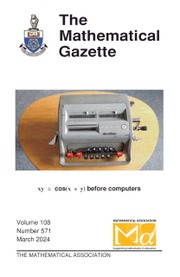No CrossRef data available.
Article contents
Two plane geometry problems approached through analytic geometry
Published online by Cambridge University Press: 18 June 2020
Extract
Geometry is a very interesting, applicable and beautiful part of mathematics. However, geometry is often difficult for students to understand and demanding for teachers to teach [1]. Constructing proofs in geometric problems turns out to be particularly difficult, even for high attaining students [2]. Sometimes, students do not even know where to start when trying to solve these [3].
- Type
- Articles
- Information
- Copyright
- © Mathematical Association 2020
References
Jones, K., Issues in the teaching and learning of geometry. In Linda Haggarty (Ed), Aspects of teaching secondary mathematics: perspectives on practice Routledge (2002) pp. 121–139.Google Scholar
Healy, L. and Hoyles, C., Students performance in proving: competence or curriculum? In Inge Schwank (Ed), European research in mathematics education I Osnabrük, Germany: Forschungsinstitut für Mathematikdidaktik (1999) pp. 153–167.Google Scholar
Fujita, T. and Jones, K., Opportunities for the development of geometrical reasoning in current textbooks in the UK and Japan, Proceedings of the British Society for Research into Learning Mathematics 22(3) (2002) pp. 79–84.Google Scholar
French, D., Teaching and learning geometry, Continuum International Publishing Group (2004).Google Scholar
Shum, K. P., Techniques for solving problems of plane geometry, in Alexander Soifer (ed.), Competitions for young mathematicians, perspectives from five continents, Springer, International Publishing (2017) pp. 55–98.Google Scholar
36th International Mathematical Olympiad (IMO, 19-20 July, 1995), Toronto, accessed January 2020 at https://www.imo-official.org/problems.aspx.Google Scholar



